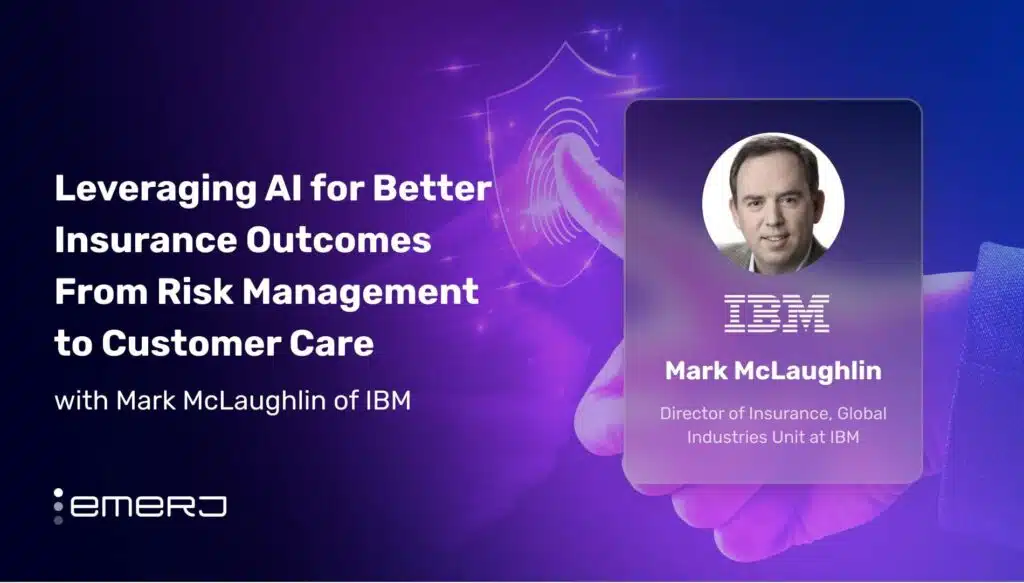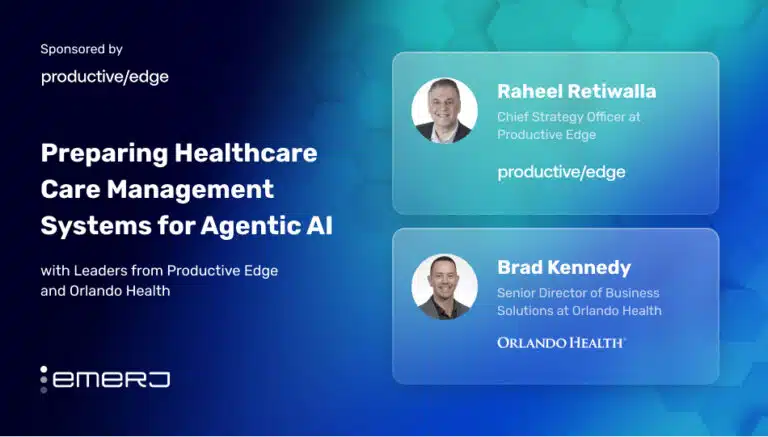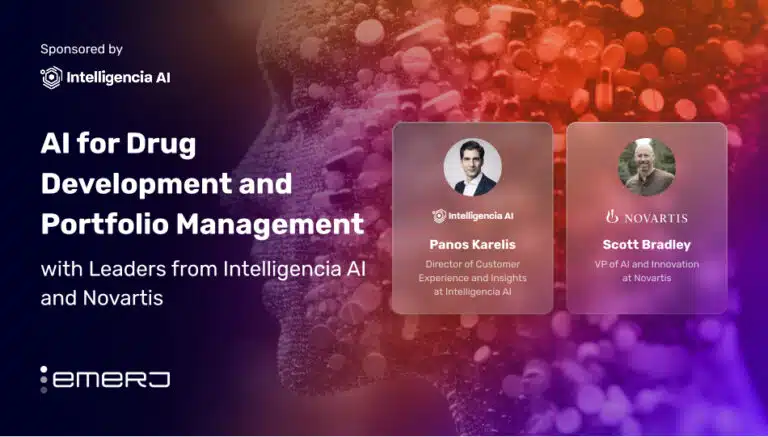AI is transforming the insurance industry from reactive claims processing to proactive risk management. Rising competition from fintech and insurtechs and growing consumer demands for personalized, real-time experiences are driving such widespread industry adoption.
Academic research highlights how insurers are increasingly using digital technologies and behavioral data to personalize services and influence customer behavior, underscoring the sector’s broader pivot toward individualized engagement.
Notably, according to a recent study from the Journal of Risk and Financial Management, firms that implemented AI-driven personalization observed a 20–25% improvement in customer retention and satisfaction metrics compared to those using traditional segmentation methods.
Mark McLaughlin, Director of Insurance at IBM’s Global Industries Unit, recently sat down with Emerj Editorial Director Matthew DeMello for a special episode of the ‘AI in Business’ podcast.
Throughout the episode, Mark highlights that insurers must move beyond traditional claims handling to actively partnering with customers in managing risks. For example, he notes that such risks include providing timely and hyper-specific alerts like “hailstones will hit your driveway in 30 minutes,” empowering customers to avoid losses proactively.
According to the International Journal of Economics, Commerce and Management, AI’s real-time data capabilities significantly enhance risk assessments and enable insurers to offer tailored policy recommendations, improving customer satisfaction and operational efficiency. Notably, insurers using AI to personalize services have reported a 15–30% increase in customer satisfaction.
By adopting advanced AI systems capable of contextual analysis, insurers can dynamically respond to customer needs and create more personalized interactions, positioning themselves ahead of competitors still reliant on rigid, reactive approaches.
This article examines three key insights for insurance leaders taken from their conversation:
- AI-driven personalization in insurance: Use real-time risk alerts and predictive analytics to reduce claims and strengthen customer relationships proactively.
- Enhancing digital labor with AI-driven automation: Automate repetitive tasks like claims processing and underwriting to improve accuracy, reduce response times, and free staff for complex customer interactions.
- Adopting hybrid AI models: Deploy smaller, task-specific AI models across business units rather than relying on centralized systems to optimize costs, efficiency, and governance.
Listen to the full episode below:
Guest: Mark McLaughlin, Director of Insurance, IBM’s Global Industries Unit
Expertise: AI in insurance, digital transformation, hybrid cloud
Brief Recognition: McLaughlin has worked in AI-driven insurance transformation for over two decades, leading AI initiatives at IBM and partnering with major insurers worldwide.
AI-Driven Personalization in Insurance
Mark begins his podcast appearance by explaining how insurance has long been viewed as a transactional, contract-driven industry, where policyholders interact with their insurers only in the event of a claim. However, AI is fundamentally changing this model by enabling insurers to proactively assist customers, anticipate risks, and provide tailored recommendations before problems arise.
McLaughlin highlights a notable shift toward predictive engagement, where AI enables real-time risk assessment and personalized insurance guidance. For example, IBM’s acquisition of The Weather Company has allowed insurers to send hyper-localized risk alerts to policyholders.
“When you send an alert saying ‘hailstones might hit Lake County tomorrow,’ customers don’t react. But when you tell them ‘hailstones will hit your driveway in 30 minutes, and they’re big enough to damage your car,’ they take action.”
– Mark McLaughlin, Director of Insurance at IBM’s Global Industries Unit
Mark insists that the high level of specificity and immediacy in AI-driven alerts transforms how policyholders view their insurers. Instead of simply handling claims after a disaster strikes, AI-driven insurers become partners in risk mitigation, actively helping customers avoid damage and reduce losses.
Beyond weather-related alerts, AI is revolutionizing policy recommendations. By analyzing customer behaviors, McLaughlin asserts that transaction history and location-based risks can suggest tailored policy modifications. For example, a homeowner moving to a hurricane-prone area might automatically receive flood and windstorm coverage recommendations, ensuring their policy aligns with their needs.
He goes on to explain that AI also identifies at-risk customers based on historical claims patterns, geographic vulnerabilities, and financial indicators. By recognizing policyholders who are more likely to experience claims disputes, insurers can engage proactively, offering preventative measures, improved coverage options, or early claim support.
Stepping back and looking at adoption in insurance at a high level, Mark tells the executive podcast audience that AI is playing an increasingly critical role in strengthening customer relationships by improving engagement at every stage of the insurance lifecycle. Insurers can cultivate more substantial connections with policyholders by leveraging AI to anticipate customer needs, provide proactive risk assessments, and offer personalized policy recommendations.
Mark emphasizes that these advancements enhance customer experience and contribute to long-term retention by positioning insurers as trusted partners rather than just claim processors.
Additionally, insurers that efficiently integrate AI-driven insights into their risk assessment models and proactively engage customers gain a significant competitive advantage. As McLaughlin explains, AI adoption is not just about automation—it enables insurers to anticipate and respond effectively to evolving consumer expectations in ways traditional methods cannot match.
Enhancing Digital Labor with AI-Driven Automation
Later in the episode, Mark and Matthew focus their conversation on how insurance operations rely heavily on manual workflows, including claims processing, compliance audits, and underwriting assessments. AI is streamlining these processes by automating repetitive tasks, reducing administrative overhead, and improving decision-making.
AI-powered claims processing is one of the most significant advancements in insurance automation. Mark explains that, traditionally, claims adjusters manually review policy documents, assess damages, and verify claimant information. AI accelerates this process by extracting relevant details, cross-referencing claims with historical data, and recommending optimal resolutions.
McLaughlin then describes how AI enhances customer service operations, particularly in call centers and digital support channels. AI-driven assistants can transcribe live customer calls, detect sentiment, and provide agents with recommended next steps, ensuring faster response times and improved customer satisfaction:
“If you call up the company and say, ‘Hey, I’ve got this claim problem,’ AI can now live transcribe that for the customer service representative, so if they didn’t hear something or need to refer back to what was said earlier in the conversation, they have the script right there in front of them. AI can also detect sentiment — whether a customer is upset or just wants a quick resolution — and recommend the next best action accordingly.”
– Mark McLaughlin, Director of Insurance at IBM’s Global Industries Unit
From these more prescriptive workflows, Mark asserts that AI-driven transcription and sentiment detection ensure faster response times and improved customer satisfaction.
He goes on to note that AI is also improving document processing and regulatory compliance by helping insurers quickly analyze legal documents, policy changes, and government regulations. AI-powered document processing reduces the time employees spend on administrative tasks while ensuring adherence to industry standards.
However, McLaughlin cautions insurers against rushing AI deployments without thoroughly refining and validating their models. Companies that move too quickly risk decreased accuracy, operational inefficiencies, and mismatches between AI-driven recommendations and customer needs.
Mark advises the executive audience that successful AI implementation requires iterative testing, proper governance, and alignment with human expertise to ensure automated systems effectively support claims processing, underwriting, and customer interactions.
The Shift to Hybrid AI Models
On the subject of model development, Mark prefaces his opinions by explaining that Many insurers initially aimed to centralize all AI capabilities into a single foundational model. However, he exempts that this approach has proven costly, inefficient, and difficult to scale. Instead, insurers are shifting toward hybrid AI models combining general-purpose and task-specific AI systems.
McLaughlin then compares the shift in AI model adoption to the evolution of cloud computing. Initially, companies expected to migrate all infrastructure to the cloud, only to realize that a hybrid approach—where critical data remains on-premise—was more practical and secure.
“Five years ago, everybody was telling me, ‘We’re going to move all of our systems to the cloud,’ but the reality is that insurers are now realizing that hybrid AI models make more sense. The average insurer has 10 clouds running today, and they still have 30 to 40% of their workload on-prem because of security, compliance, and performance considerations. The same is true for AI models—one large model won’t cut it. Instead, you need the right tool for the job.”
– Mark McLaughlin, Director of Insurance at IBM’s Global Industries Unit
Additionally, Mark observes that insurers are focusing on AI interoperability, ensuring that different AI models work seamlessly together. By implementing flexible AI architectures, insurers can integrate multiple AI-driven processes across departments without disrupting existing operations.
According to McLaughlin, insurers adopting hybrid AI models and establishing decentralized governance frameworks can better anticipate and respond to market shifts, regulatory demands, and evolving customer expectations, gaining clear competitive advantages over those dependent on traditional or overly centralized AI approaches.

















